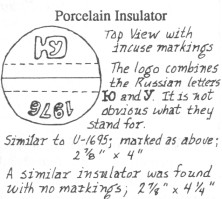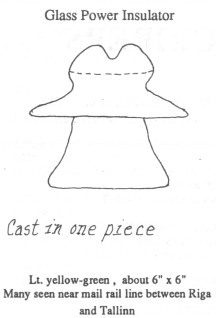Foreign Insulators
by Marilyn Albers
Reprinted from "Crown Jewels of the Wire", February 1988, page 16
I'm moving over this month for guest editor Donald Fiene, who will delight us
with another story about his travels to Russia. Enjoy! Marilyn
SOVIET INSULATOR REPORT, 1987
Between June 15 and July 2, 1987, I led a group of 46 Americans, mostly from
East Tennessee, on a tour of the USSR as follows: 3 days in Leningrad, 2 days
each in the capital cities of the Baltic Republics -- Vilnius (Lithuania), Riga
(Latvia), and Tallinn (Estonia), 5 days in Moscow and 1 day to recover in
Helsinki. Last year, traveling in Central Asia, I found tons of beautiful glass,
only to have all of it seized in Customs. This year our baggage was not searched
at all and I could have gotten anything through -- but all I had managed to pick up
was ten rather ordinary pieces of white porcelain. C'est la vie!
Last year in Leningrad I traded U.S. military insignia for glass insulators,
banners and Soviet army gear such as belts and epaulets. This year I tried to
make contact with my two teenage suppliers, but failed. However, I was quickly
"found" by two others as I walked about in a residential-industrial
area near one of the big canals. I had poked around in alleys and courtyards for
two hours without finding a single insulator or liberating a single porcelain
street sign (with which the city abounds). The boys wanted to do business. I
showed them my incredible number of military patches and they flipped out. But
I told them that I would only trade for glass insulators, Soviet flags or
porcelain signs. They thought I was a "loonie," but went to work with
a will. The next day they showed up at the appointed place with four beautiful
porcelain signs and two lousy little porcelain -- one of which was only 7/8"
high, making it undoubtedly the smallest insulator in the world (especially
considering that it is used with 220-volt house wires), which is nevertheless
something, I suppose.

I told them they had to come up with more stuff to fulfill our contract;
nevertheless, I gave them all the goods I had -- just to see if they would show up
the next day (my last in Leningrad) as agreed. And they did show up, though they
could easily just have disappeared. They told me it was absolutely "hell" trying to find glass insulators in Leningrad. They had spent
the whole night searching. However, they did have two flags for me (each about 3'x 4') which I accepted as sufficient to fulfill the bargain. Of course, I did
very well in this trade. Getting those porcelain signs (one of them 6" x
18") out of the country was a great coup -- they date to the pre-war Stalin
period. The best one, originally bolted to the side of a building, is a marker
for "Soviet St."
In touring the old, medieval part of the city of Vilnius, I noticed a number
of very dark aqua glass insulators (about the size of CD 563) on the sides of a
building marked for renovation. They were probably about 60 years old and all
were too high to reach without a ladder. There were ladders for the borrowing at
nearby construction sites, but I was afraid to use them. The narrow streets were
thronged with people. It was a holiday -- St. John's Eve, celebrating the summer
solstice. The best I could do was free up a small strain insulator -- a new type
for these reports that I found attached to a length of cable near the fence of a
construction area. I pulled the insulator and cable through the fence, sat on
the ground with it, and worked the strands of the cable loose one at a time with
a pair of pliers. It took me 15 minutes, during which time several people
stopped to ask me directions. I told them all the same thing. "Straight
ahead and turn right."

That evening, scouting an industrial area with a friend on the trip who
collects pole and railroad date nails, I found hundreds of discarded porcelain
insulators. Of these I kept only five pin types, with three duplicates for
trading.

It was my bad luck they were all virtually the same. I also kept one example
each of a 100-amp and a 400- amp fuse.
I did some serious hunting in Riga, mostly in train yards, but found
nothing. Thereafter I got too busy to search. However, I noticed from the windows of our train enroute from Riga to Tallinn an
interesting power
line with beautiful yellow-green insulators of a shape that I believe has not...

In Moscow I saw nothing interesting, as usual. However, on a side trip to a
monastery in the city of Zagorsk, about fifty kilometers away, I saw a line of
power insulators mounted on cros sarms that were almost certainly CD 304.5. l
also noted some CD 540's that were of clear glass (perhaps the first clear
glass I have seen in the USSR). I observed as well some very large insulators on crossarms, pin-type, but apparently as large as sombreros; they
were either brownish-amber color or dirty (probably the former). Finally, I saw
a number of installations of standard sombrero-type insulators -- with the number
of units ranging as high as 25. I doubt that I have ever seen a string that long
in the U.S. Has anyone?
I forgot to mention that on our only night in Helsinki I went out for about
three hours in a cold rain, traversing a giant train yard in about five
directions.
When I returned, I was ready for a nice cold beer in the bar. It tasted great.
But it cost me $6.00 for the glass. I had two more, I was that thirsty. In
Moscow, I drank Heinekens at $1.25 a can.
Aside from
the poor haul in insulators, the trip was an excellent one, fully reflecting the
current liberal mood in the USSR. About 600,000 Americans go there yearly. The
number is rising rapidly. Next year I intend to take my tour group not only to
Leningrad and Moscow, but also to Yalta, Odessa and the Republic of Moldavia
(formerly known as Bessarabia, the home of the gypsies).
|
